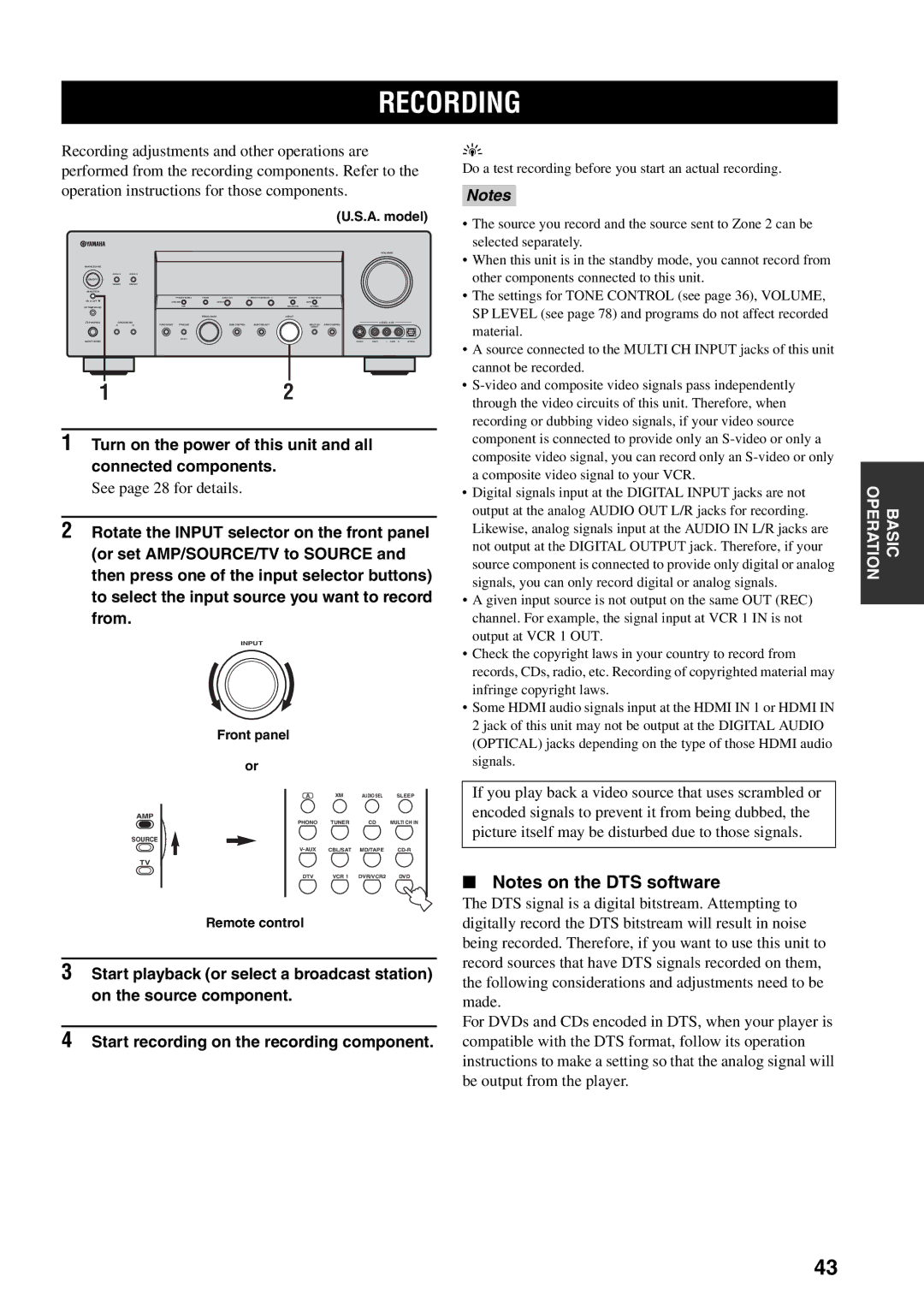
RECORDING
Recording adjustments and other operations are performed from the recording components. Refer to the operation instructions for those components.
(U.S.A. model)
VOLUME
MAIN ZONE
ON/OFF |
|
|
|
|
|
| ON/OFF | ON/OFF |
|
|
|
MASTER |
|
|
|
|
|
ON :OFF |
|
|
|
|
|
OPTIMIZER MIC |
|
|
|
|
|
|
|
| PROGRAM |
| INPUT |
PHONES | SPEAKERS |
|
| VIDEO AUX | |
|
| PURE DIRECT STRAIGHT | TONE CONTROL | AUDIO SELECT | MULTI CH ZONE CONTROL |
|
|
|
|
| INPUT |
SILENT CINEMA |
|
|
|
|
|
1 | 2 |
1Turn on the power of this unit and all connected components.
See page 28 for details.
2Rotate the INPUT selector on the front panel (or set AMP/SOURCE/TV to SOURCE and then press one of the input selector buttons) to select the input source you want to record
from.
INPUT
Front panel or
A XM AUDIO SEL SLEEP
AMP
PHONO TUNER CD MULTI CH IN
SOURCE
CBL/SAT | MD/TAPE | ||
TV |
|
|
|
DTV | VCR 1 | DVR/VCR2 | DVD |
Remote control
3Start playback (or select a broadcast station) on the source component.
4Start recording on the recording component.
y
Do a test recording before you start an actual recording.
Notes
•The source you record and the source sent to Zone 2 can be selected separately.
•When this unit is in the standby mode, you cannot record from other components connected to this unit.
•The settings for TONE CONTROL (see page 36), VOLUME, SP LEVEL (see page 78) and programs do not affect recorded material.
•A source connected to the MULTI CH INPUT jacks of this unit cannot be recorded.
•
•Digital signals input at the DIGITAL INPUT jacks are not output at the analog AUDIO OUT L/R jacks for recording. Likewise, analog signals input at the AUDIO IN L/R jacks are not output at the DIGITAL OUTPUT jack. Therefore, if your source component is connected to provide only digital or analog signals, you can only record digital or analog signals.
•A given input source is not output on the same OUT (REC) channel. For example, the signal input at VCR 1 IN is not output at VCR 1 OUT.
•Check the copyright laws in your country to record from records, CDs, radio, etc. Recording of copyrighted material may infringe copyright laws.
•Some HDMI audio signals input at the HDMI IN 1 or HDMI IN 2 jack of this unit may not be output at the DIGITAL AUDIO (OPTICAL) jacks depending on the type of those HDMI audio signals.
If you play back a video source that uses scrambled or encoded signals to prevent it from being dubbed, the picture itself may be disturbed due to those signals.
■Notes on the DTS software
The DTS signal is a digital bitstream. Attempting to digitally record the DTS bitstream will result in noise being recorded. Therefore, if you want to use this unit to record sources that have DTS signals recorded on them, the following considerations and adjustments need to be made.
For DVDs and CDs encoded in DTS, when your player is compatible with the DTS format, follow its operation instructions to make a setting so that the analog signal will be output from the player.
OPERATION | BASIC |
|
|
43
